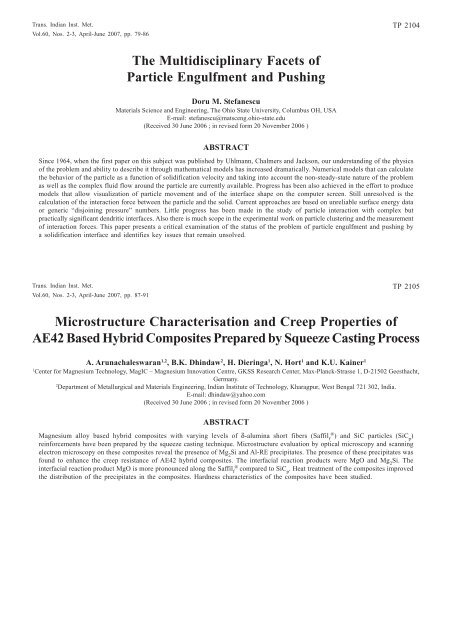Vol.60, Nos. 2-3 - Indira Gandhi Centre for Atomic Research
Vol.60, Nos. 2-3 - Indira Gandhi Centre for Atomic Research
Vol.60, Nos. 2-3 - Indira Gandhi Centre for Atomic Research
You also want an ePaper? Increase the reach of your titles
YUMPU automatically turns print PDFs into web optimized ePapers that Google loves.
Trans. Indian Inst. Met.<br />
<strong>Vol.60</strong>, <strong>Nos</strong>. 2-3, April-June 2007, pp. 79-86<br />
TP 2104<br />
The Multidisciplinary Facets of<br />
Particle Engulfment and Pushing<br />
Doru M. Stefanescu<br />
Materials Science and Engineering, The Ohio State University, Columbus OH, USA<br />
E-mail: stefanescu@matsceng.ohio-state.edu<br />
(Received 30 June 2006 ; in revised <strong>for</strong>m 20 November 2006 )<br />
ABSTRACT<br />
Since 1964, when the first paper on this subject was published by Uhlmann, Chalmers and Jackson, our understanding of the physics<br />
of the problem and ability to describe it through mathematical models has increased dramatically. Numerical models that can calculate<br />
the behavior of the particle as a function of solidification velocity and taking into account the non-steady-state nature of the problem<br />
as well as the complex fluid flow around the particle are currently available. Progress has been also achieved in the ef<strong>for</strong>t to produce<br />
models that allow visualization of particle movement and of the interface shape on the computer screen. Still unresolved is the<br />
calculation of the interaction <strong>for</strong>ce between the particle and the solid. Current approaches are based on unreliable surface energy data<br />
or generic “disjoining pressure” numbers. Little progress has been made in the study of particle interaction with complex but<br />
practically significant dendritic interfaces. Also there is much scope in the experimental work on particle clustering and the measurement<br />
of interaction <strong>for</strong>ces. This paper presents a critical examination of the status of the problem of particle engulfment and pushing by<br />
a solidification interface and identifies key issues that remain unsolved.<br />
Trans. Indian Inst. Met.<br />
<strong>Vol.60</strong>, <strong>Nos</strong>. 2-3, April-June 2007, pp. 87-91<br />
TP 2105<br />
Microstructure Characterisation and Creep Properties of<br />
AE42 Based Hybrid Composites Prepared by Squeeze Casting Process<br />
A. Arunachaleswaran 1,2 , B.K. Dhindaw 2 , H. Dieringa 1 , N. Hort 1 and K.U. Kainer 1<br />
1<br />
Center <strong>for</strong> Magnesium Technology, MagIC – Magnesium Innovation <strong>Centre</strong>, GKSS <strong>Research</strong> Center, Max-Planck-Strasse 1, D-21502 Geesthacht,<br />
Germany.<br />
2<br />
Department of Metallurgical and Materials Engineering, Indian Institute of Technology, Kharagpur, West Bengal 721 302, India.<br />
E-mail: dhindaw@yahoo.com<br />
(Received 30 June 2006 ; in revised <strong>for</strong>m 20 November 2006 )<br />
ABSTRACT<br />
Magnesium alloy based hybrid composites with varying levels of -alumina short fibers (Saffil f ® ) and SiC particles (SiC p<br />
)<br />
rein<strong>for</strong>cements have been prepared by the squeeze casting technique. Microstructure evaluation by optical microscopy and scanning<br />
electron microscopy on these composites reveal the presence of Mg 2<br />
Si and Al-RE precipitates. The presence of these precipitates was<br />
found to enhance the creep resistance of AE42 hybrid composites. The interfacial reaction products were MgO and Mg 2<br />
Si. The<br />
interfacial reaction product MgO is more pronounced along the Saffil f<br />
®<br />
compared to SiC p<br />
. Heat treatment of the composites improved<br />
the distribution of the precipitates in the composites. Hardness characteristics of the composites have been studied.
















